|
|
|
|
| Home > Reviews > 1/48 Scale > Tamiya Kit No. 32597 - Panther Ausf. D |
Panther Ausf. D
Tamiya, 1/48 scale
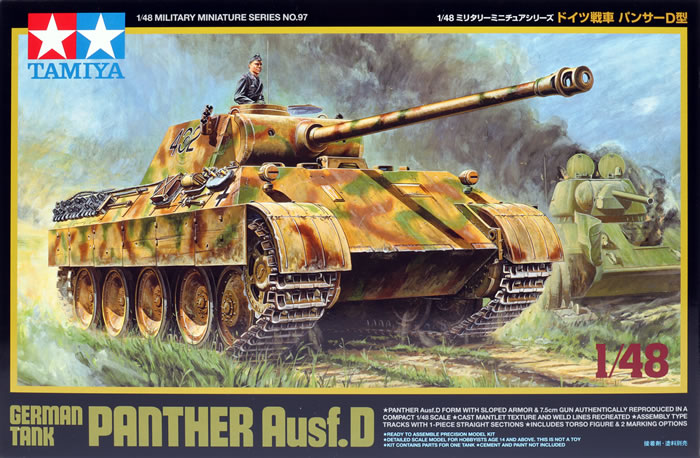
| Catalogue Number and Description: | Tamiya Kit No. 32597 - Panther Ausf. D |
| Contents and Media: | 175 parts in tan coloured plastic; one die-cast metal lower hull; four polythene caps; two metal screws; one length of black cotton thread; markings for two Kursk vehicles. |
| Scale: | 1/48 |
| Price: | 2,300 yen |
| Review Type: | FirstLook |
| Advantages: | Accurate in shape: excellent link and length tracks; crisp detail; easy to build; Commander figure included. |
| Disadvantages: | |
| Recommendation: | Tamiya’s mid-scale Panther Ausf. D is a well detailed kit and will be easy to build. This is another welcome addition to Tamiya's 1:48 scale military vehicle family.. |
Background
The Panther was a German medium tank deployed during World War II on the Eastern and Western Fronts in Europe from mid-1943 to its end in 1945. It had the ordnance inventory designation of Sd.Kfz. 171.
The Panther was intended to counter the Soviet T-34 and to replace the Panzer III and Panzer IV. Nevertheless, it served alongside the Panzer IV and the heavier Tiger I until the end of the war.
It is considered one of the best tanks of World War II for its excellent firepower and protection, although its reliability was less impressive.
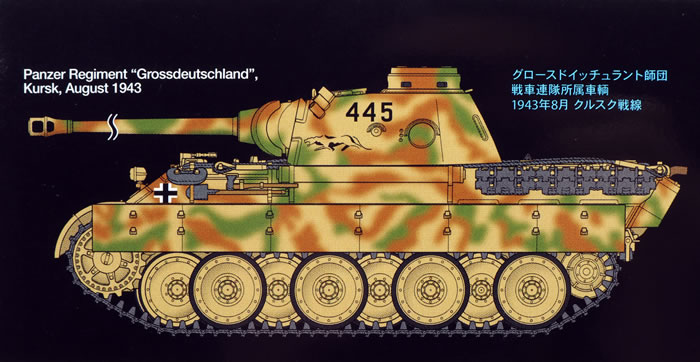
The Panther was a compromise. While having essentially the same engine as the Tiger I, it had more efficient frontal hull armour, better gun penetration, was lighter and faster, and could traverse rough terrain better than the Tiger I.
The trade-off was weaker side armour, which made it vulnerable to flanking fire.
The Panther proved to be effective in open country and long range engagements, but did not provide enough high explosive firepower against infantry.*
The Panther Ausf. D was the first production version. It was rushed into service for the Kursk offensive in July 1943.
*Historical summary courtesy of Wikipedia https://en.wikipedia.org/wiki/Panther_tank
FirstLook
Tamiya revitalised the mid-sized 1:48 scale military market in 2004 with their brand new Tiger I Early Production kit. A number of Axis and Allied releases rapidly followed, with the 1:48 scale Panther Ausf. G appearing in 2005.
Tamiya has now added to their Panther family with an Ausf. D.This new 1:48 scale Panther Ausf. D comprises 175 parts in tan coloured plastic, one die-cast metal lower hull; four polythene caps; two metal screws; one length of black cotton thread and markings for two Kursk vehicles.
Tamiya hasn't taken any short cuts with their new 1:48 scale Panther Ausf. D. All the plastic sprues are new, accurately representing the differences between the early and late Panthers including the Ausf. D's unique turret with its dustbin cupola and side pistol ports, the hull with its staggered lower sides, machine gun flap and driver's visor in the glacis; 16-bolt road wheels and early-style tracks.
Tamiya has included a die-cast lower hull for "scale weight". This appears to be the sole part left over from the 2005 Panther Ausf. G kit. The plastic upper hull and metal lower hull are fixed via two metal screws. These will be totally hidden when the model is complete.
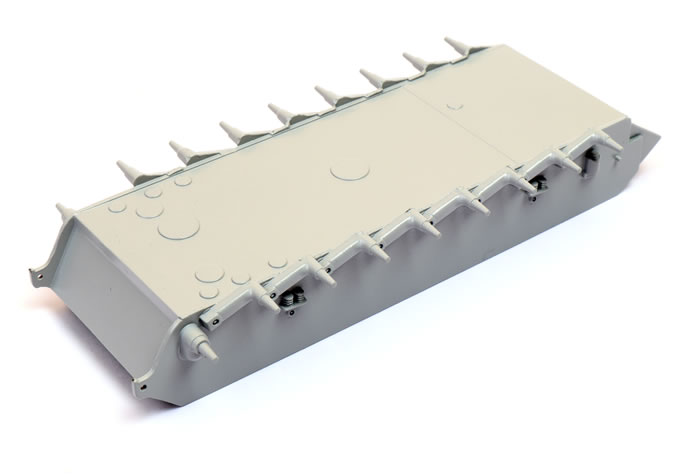
The Commander's cupola features a separate hatch that may be posed open or closed, but the driver's and radio operator's hatches are moulded shut. The drivers visor and the machine gun hatch are separate parts but there is no internal hinge mechanism provided so you'll need to do a little scratch buiding if you want to display them open.
A Commander figure is included. He is as well detailed as you would expect from Tamiya's recent figure offerings.
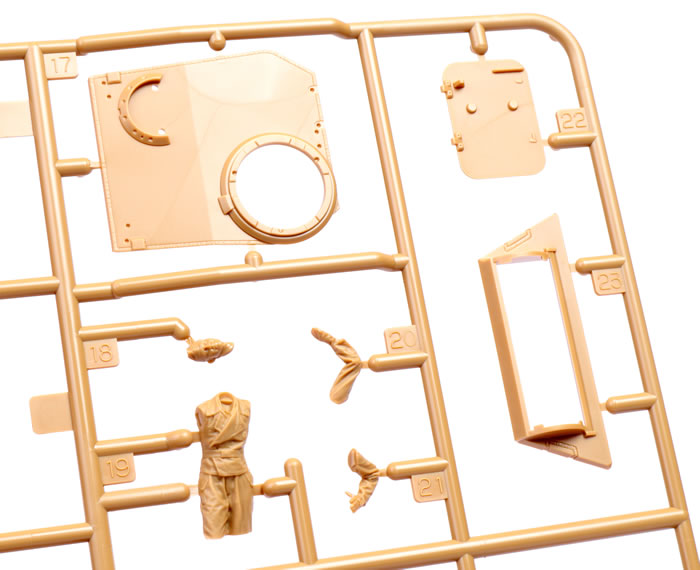
The drive sprockets are attached via polythene caps, while the idler wheel and the road wheels are simply glued to the fixed metal axle ends.
Tracks are link and length, with one lower run for the lower section, two lengths for the upper run and a combination of single, four-link and five-link sections to cover the drive sprocket, idler wheel and the gaps between the top and bottom runs. I have built quite a few of these Tamiya 1:48 scale link-and-length tracks, and they have always proven to be easy to install. The sag along the upper run is also very convincing.
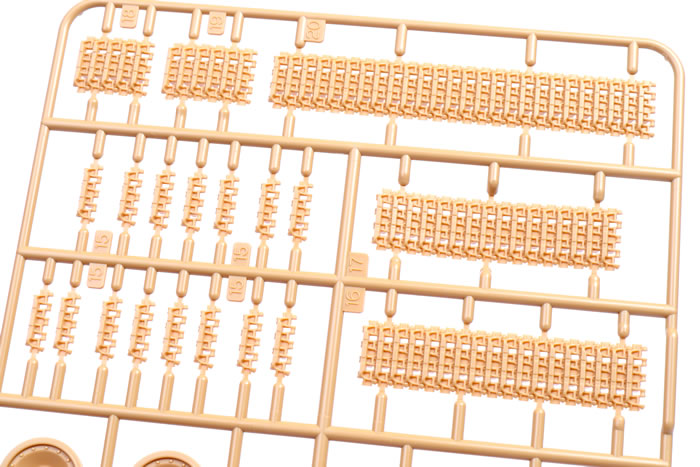
Tamiya provides the front mudgaurd extensions and early-style six-panel side skirts. The gun travel lock is a separate parts and may be posed up or down.
The small decal sheet provides markings for two vehicles that fought at Kursk in July 1943.
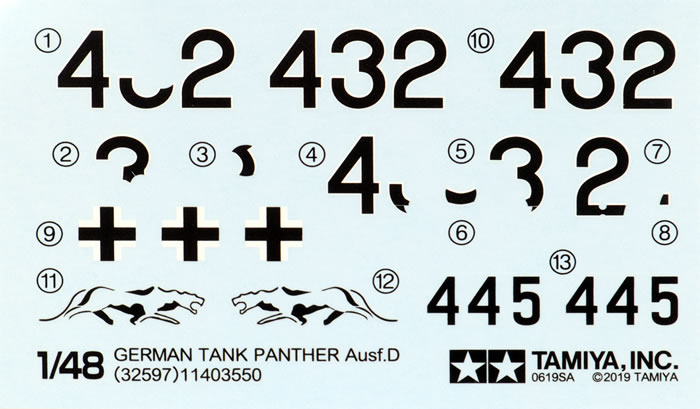
Both vehicles are finished in mid-war three-colour camouflage of Dark Yellow, Red Brown and Dark Green.
Decals are in register and well printed.
Conclusion
Tamiya’s mid-scale Panther Ausf. D is a well detailed kit and will be easy to build. This is another welcome addition to Tamiya's 1:48 scale military vehicle family.
Thanks to Tamiya Japan for the sample
Tamiya kits are distributed in the UK by The Hobby Company Limited
Text and Images by Brett Green
Page Created 15 September, 2019
Page Last Updated
16 September, 2019












